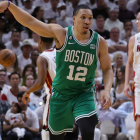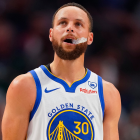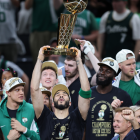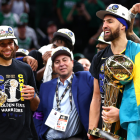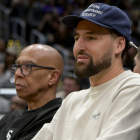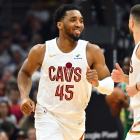
If it seems like all anyone talks about these days is 3-point shooting, it's for good reason. We've seen games, playoff series and championships swing on which team catches fire from behind the arc, and that will only be more true moving forward now that the shot is more prevalent than ever. The 2023 Eastern Conference finals between the Boston Celtics and Miami Heat have been a perfect example.
During the regular season, the Celtics were a 3-point machine, making 37.7% of their 42.6 attempts per game. The Heat, meanwhile, cashed in just 34.4% of their 34.8 attempts.
You would never have guessed by watching the first three games, as the Heat jumped out to a stunning 3-0 lead in large part because of some red-hot outside shooting. In Games 1-3, the Heat went 44-of-92, while the Celtics were 31-of-106. That 39-point differential from the 3-point line matched the Heat's overall point differential for the series.
That all changed in Tuesday's Game 4, as the Celtics put together their best 3-point performance of this round and kept their season alive with a 116-99 win. Boston poured in 18 3-pointers on 45 attempts, while the Heat made just eight of their 32 tries. The big question, then, is how? How did the Celtics unlock the Heat's defense and finally get back to their usual ways.
It all started with the paint.
While we've seen the Celtics have success scoring inside in this matchup, particularly in Game 1 when they shot 31-of-47 en route to 62 points in the paint, this was the first gime that they were able to fully optimize their drive-and-kick game. The "ball was popping," as Jayson Tatum put it during his postgame press conference.
Here's a look -- game by game and then the series as a whole -- at the Celtics' 3-point attempts when they get a paint touch before the shot and when they do not get a paint touch first. (Stats do not include garbage time of Game 3.)
| 3-pointers | Paint touch | No paint touch |
|---|---|---|
Game 1 | 2-10 | 8-19 |
Game 2 | 4-9 | 6-26 |
Game 3 | 4-9 | 2-18 |
Game 4 | 8-18 | 10-27 |
Full series | 18-46 (39.1%) | 26-90 (28.9%) |
The ball getting into the paint doesn't guarantee a good look, just as the ball not going inside first doesn't inherently mean it was a bad shot. However, as you can tell, the difference in the Celtics' shooting performance between the two scenarios is staggering.
Coming into Game 4, they had only taken 28 total 3s after getting the ball into the paint; they took 18 such attempts on Tuesday and made 44.4% of them.
That mindset was clear from the opening possession, when Tatum caught the ball at the top of the key and made an immediate, hard drive to the paint, drew all five Heat defenders towards him and kicked it out to Al Horford for a catch-and-shoot opportunity.
"It was good [to see a shot go down]," said Horford, who was 3-of-13 from downtown in the first three games. "The biggest thing is the ball movement. You see our game tonight, the ball wasn't sticking and I feel like we found what it takes to be the best version of ourselves."
When the Celtics went on their game-changing 18-0 run in the third quarter, which put them ahead for good, they made multiple such 3s. First, there was a clean look for Tatum, which helped him get into a groove for the remainder of the game. (It's also worth noting this look came in semi-transition and after a miss. That the Celtics' best 3-point shooting and best defensive performances of the series coincided with each other was no coincidence; it's a lot easier to get into the paint and make the Heat scramble when they can't set their defense.)
On the latter, a wide-open look for Derrick White in the corner that started with a drive by Marcus Smart, commentator Stan Van Gundy was raving about their ball movement.
There's always a "make or miss league" element to outside shooting, and the Celtics made more shots than the Heat in Game 4. But they turned around the 3-point battle and saved their season because they went about getting them the right way. They'll need to maintain that approach the rest of the way if they want to make history and pull off a miraculous comeback.
"We trusted in each other, we believed in each other continuously," Smart said. "Even when we were down, we continuously believed in each other, and that's what we've got to continue to do. No matter what we've got to continue to play the right way, continue to believe in each other, and let the chips fall where they may."









